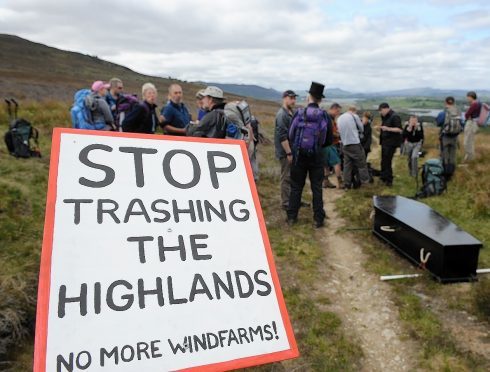A windfarm which would have added to the “ring of steel” around Loch Ness has been scrapped.
German energy firm E.ON has quietly announced its decision on its website, stunning objectors.
The withdrawal of the 18-turbine Glenmoriston scheme near Fort Augustus has delighted local residents in equal measure after a concerted three-year campaign opposing a project that many argued would have blighted an iconic landscape and threatened a fragile ecosystem.
A brief statement on the firm’s website said: “After careful consideration E.ON has made the decision not to progress with the proposed 18-turbine Moriston Wind Farm.
“Following a detailed review of the project including feedback from consultees including the planning authority and Scottish Natural Heritage, E.ON has considered the site unsuitable.”
It offered gratitude to the local community “for their patience and valuable feedback.”
E.ON has 12 onshore wind projects in various stages of development in Scotland. While it had consulted the local community, no planning application had been submitted.
Fort Augustus and Glenmoriston Community Council chairwoman Carol Pritchard said: “We weren’t impressed by what they were suggesting and it was clear the community were very strongly opposed to it. It would have had a very high visual and cumulative impact.”
Echoing that, biologist Jim Treasurer of the Friends of the Great Glen pressure group which has fought the spread of huge turbines in the area, said: “Any cessation in the development of windfarms and associated infrastructure is good news for the vista economy of the Loch Ness and Great Glen areas.”
Highland anti windfarm campaigner Lyndsey Ward accused E.ON of “slinking away from an appalling proposal after causing many months of unnecessary anguish and uncertainty for people living there.”
The Glenmoriston proposal featured in a “Save Loch Ness” video montage that went viral last year.
More than 500 giant turbines have been built, approved or are in planning within 22 miles of the loch, prompting serious concern about the possible negative effects on lifeline tourism.
Loch Ness attracts more than a million visitors each year.
The Scottish Government has defended the spread of turbines saying its policy on onshore windfarms “aims to strike a balance between utilising Scotland’s significant renewable energy resources while protecting our finest scenic landscapes and natural heritage.”
